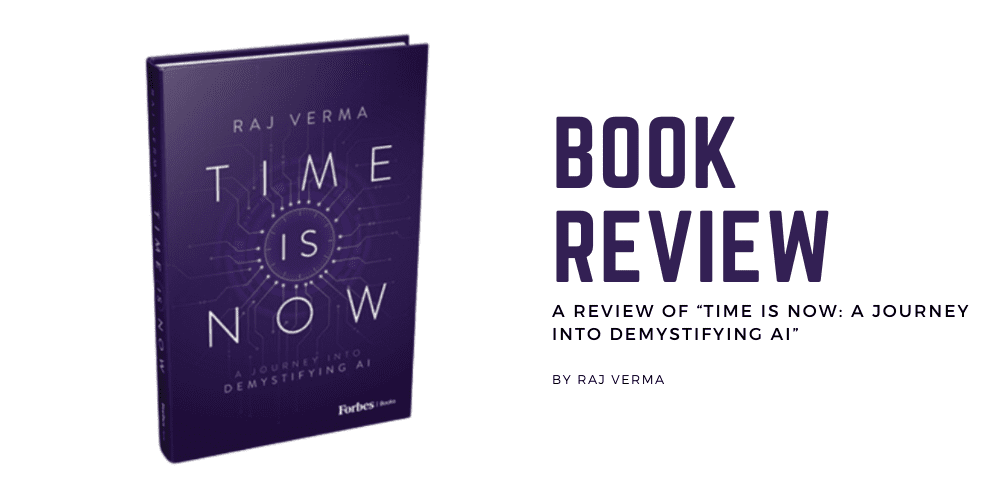A Review of 'Time is Now' by Raj Verma: Charting the Course of AI in Modern Society

How will Artificial Intelligence (AI) shape the future of humanity? It’s up to humans to figure that out, says Raj Verma in his new book, Time is Now: A Journey Into Demystifying AI. As a tech veteran and CEO of SingleStore, a data technology company, Verma has deep industry insight into the way AI works and how it is being developed. He is both an AI optimist and pragmatist, aware of the technology’s unprecedented potential to transform the world while cognizant of its many risks. His book encourages people to embrace AI, not necessarily as artificial intelligence, but as amplified intelligence. This means taking control of the helm of AI, steering it down the path that positively transforms our world. Verma’s book is a timely contribution to the ongoing conversation about AI’s impact on society.
About the Author: Who is Raj Verma?
Verma views AI through the lens of how data is used to fuel this technology. In Time is Now, he emphasizes that without data, AI is useless. As the CEO of one of the most exciting data technology companies in Silicon Valley, Verma is an important player in the development of many AI applications. He has transformed SingleStore from an SQL database company to a real-time comprehensive data platform that can store, process and analyze all kinds of data. Verma has also steered SingleStore to increase its annual recurring revenue tenfold in just four years.
Before joining SingleStore, Verma served as CMO, EVP of Global Sales, and COO of TIBCO, where he also played a crucial role in growing the company’s revenue to over $1 billion. Verma also held significant leadership roles as COO and CRO at Aptus Software and COO at Hortonworks.
Verma holds a Bachelor’s degree in Computer Science from BMS College of Engineering in Bangalore, India.
Overview of the Book
Verma interweaves insights from his personal life, career journey, and experiences in the tech industry to explain how humans can use AI ethically to amplify not only our intelligence, but also our actions and choices. The book is divided into three parts:
How We Got Here
Verma introduces the concept of real time, a term often used in the tech world to denote the processing of data in motion, by comparing it to living in the now. According to Verma, we live in the now by drawing from our memories (or information embedded in our head), putting them in context, and using them to make choices throughout every moment of our lives. He highlights personal anecdotes, from career choices to family decisions, to illustrate his concept of now and how we live it. As he tells his personal story, Raj also delves into the history of important technological developments, setting the scene for the moment in which generative AI became a reality.
Where We Are
Verma continues to explain technological development and how companies have adopted its many expressions while mirroring his own story. We learn how he came to value the concept of real time, and how he got to Silicon Valley. This section starts to take readers deep into AI’s development. Verma discusses how AI is being integrated into daily decision making processes within businesses. He makes the case for AI to be seen as a technology that, more than automating tasks, can complement and amplify human intelligence and decision making capacities.
Where We Are Going
The final part of the book dives deep into explaining AI for the non-tech savvy. Verma goes back to his three pillars of now (information, context, and choice) to illustrate how AI works in ways similar to human brains. This chapter underscores the importance of data for AI. An AI application’s efficacy depends on its access to the best and most accurate data, embedded within the right context, and delivered at the exact moment needed.
Key Themes and Insights
Verma explores several major themes throughout “Time is Now”:
- Ethical Use of AI: A recurring theme is the moral responsibility humans have to develop this technology to have a positive impact. He argues that we cannot afford to go wrong with AI the same way we did with social media, which has caused mental health issues among teenagers.
- Enhancement of Human Intelligence: Verma says AI should be viewed as a way to amplify human intelligence. It is a powerful tool that gives us unprecedented insight, which in turn empowers us to make better, more impactful decisions.
- AI will enhance our capacity to live the Now: AI can digest immense amounts of data and deliver insight in milliseconds. This means that through AI, we can have access to immediate insights that we can use to make better decisions in the now.
Raj Verma’s Vision for a Future with AI
Verma is optimistic about AI. He doesn’t believe in doomsayers’ dystopian warnings that one day AI will control humanity. Instead, his concerns around AI revolve around issues like AI bias and hallucinations.. In the end, Verma makes it clear that AI is an opportunity that will transform humanity.
Strengths of the Book
One of the book’s major strengths is that it is accessible to non-technical readers. The book’s narrative style and engaging prose communicates complex ideas effectively.
Moreover, he uses personal anecdotes to illustrate technical concepts, including how AI is currently used across many industries. These examples not only demonstrate the technology’s versatility but also its potential to drive significant change, providing a concrete basis for Verma’s optimistic outlook.
Comparative Analysis
Time is Now stands out from other AI literature, such as Kai-Fu Lee’s AI Superpowers or Nick Bostrom’s Superintelligence, by focusing more on the practical applications of AI and its ethical implications rather than just theoretical or future risks. Verma’s optimistic and practical approach provides a refreshing contrast to more cautionary tales about AI.
The book fits well within the broader literature on AI by adding a unique blend of personal insight and practical advice, which is less common in more academically oriented texts that prioritize technical details over practical implications.
Recommendations
This book is highly recommended for technology professionals, business leaders, and policymakers who are involved in or interested in the integration of AI into business and society. It is also suitable for a general readership thanks to its accessible language and engaging examples.
To get the most out of this book, readers should approach it not just as a source of information about AI but as a guide to thinking about technology ethically and responsibly. It encourages active consideration of how we can use AI to benefit society, making it a useful read for anyone interested in the ethical dimensions of technology.
Conclusion
Ultimately, Time is Now by Raj Verma is a timely and important contribution to the dialogue about AI’s role in society. It successfully navigates the fine line between the potential benefits and challenges of AI, making a compelling case for its ethical use. Verma’s book is a call to action for responsible and thoughtful engagement with one of the most powerful technologies of our time, urging us to use AI not just to enhance business processes but to improve human lives.
For anyone interested in understanding the impact of AI today and its potential for tomorrow, “Time is Now” offers indispensable insights and guidance. We highly recommend picking up a copy to explore how AI can be a force for good in reshaping our world.






